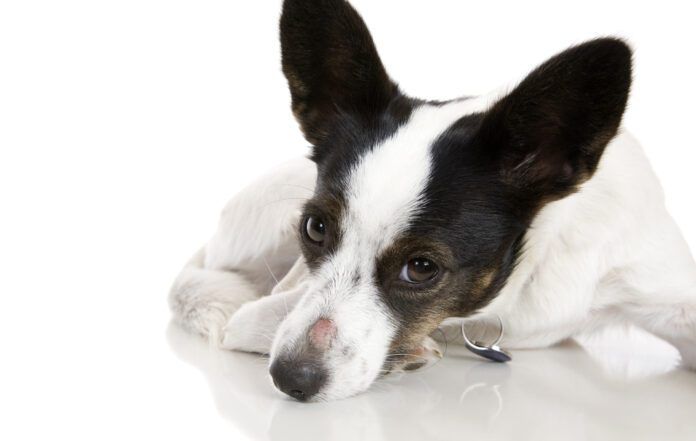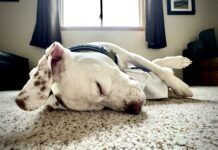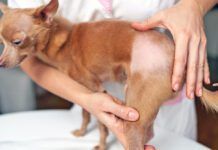Ringworm on a dog appears as a dry, hairless, circular spot, while a hot spot tends to angry, red, moist lesions that are itchy.
What does ringworm look like on a dog? Ringworm causes small, circular, hairless patches. You may notice scales or crusting, possibly with a red outline on the patches. These tend to be “dry” lesions. While ringworm may be itchy, it is generally a mild pruritus. If it’s itchy, there may be a secondary infection. Note: Ringworm is highly contagious to you and other animals.
What is a hot spot on a dog? Hot spots are usually angry, red, moist lesions. They come on fast and are painful and itchy. Most lesions start out small but grow rapidly as your dog licks and chews. The shape of the lesion is usually irregular. There may be a pus like or yellow serous discharge. Hot spots are often a warm-weather problem.
Ringworm vs. Hot Spots in Dogs
| Ringworm | Hot Spot | |
|---|---|---|
| Cause | Fungal infection | Varies; most common is a bacterial infection |
| Appearance | Dry, scaley, usually circular patches | Angry, red, moist lesions that are painful and itchy |
| Contagious | Yes to other animals and humans | No |
| Common Causes | Contact with another infected animal, bedding, or soil | Fleas, allergies, wet undercoat such as from swimming |
| Treatment | Antifungal medications | Antibacterial cleansing solutions |
Both disease processes may appear on the head and neck, with hot spots often showing up under a dropped ear or on the hip or groin area as well. While ringworm is a primary skin problem, hot spots have an underlying cause such as allergies or flea infestations.
Treatment of Hot Spots in Dogs
Treatment for a hot spot is relatively uncomplicated. Because the lesions are “wet,” you want to dry the area. Start by trimming the hair around the hot spot. Long hairs will delay healing and irritate the sore area. Hot spots are painful, so enlist a helper to restrain your dog and consider the use of a muzzle.
Chlorhexidine is a popular medicinal antibacterial cleaning solution. Clean gently, then dry gently. Your veterinarian may recommend an ointment or a powder (foot powder often works well). If the site was badly infected, antibiotics may be dispensed. A low, tapering dose of a corticosteroid may be prescribed to help with the pruritus (itching).
Pain medications may be dispensed for the first couple of days post diagnosis. It is important to keep your dog from going back and licking and chewing at the hot spot again. An Elizabethan collar may be necessary.
Try to determine the underlying cause, which is likely fleas or allergies. Treat those to prevent recurrence (getting rid of fleas is not easy). However, it may be something as simple as not drying your dog completely after a swim on a hot, humid day.
Treatment of Ringworm in Dogs
Treating ringworm is more complicated due to its contagiousness. You may need to treat all your pets. If you only have the one dog, you can try isolation to contain the fungus.
The hair itself may have fungal spores, so you need to clean and disinfect the house thoroughly. Vacuum and mop daily, taking precautions to keep you ringworm-free as well. All bedding, toys, bowls, and grooming tools need to be frequently and carefully cleaned.
Antifungal baths and topicals may work for a limited infection caught early on, but most dogs will need a prescription for an antifungal medication.
Both these skin infections use require the help of a veterinarian. Delaying the help of your vet with makeshift remedies will make treatment longer and more difficult.






